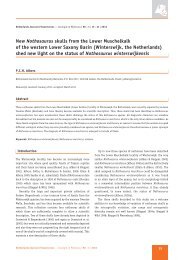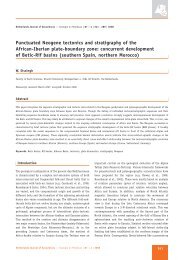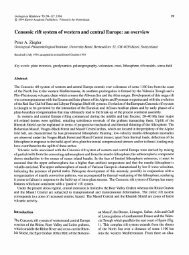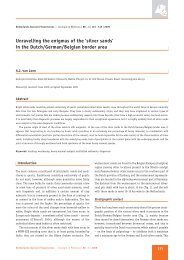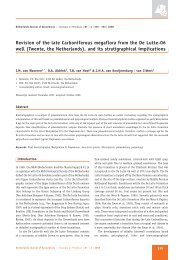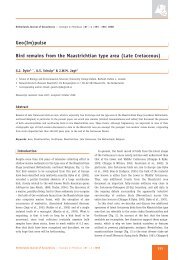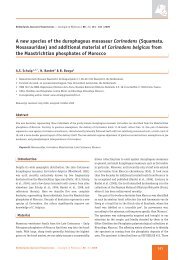Diagnostic sedimentary structures of the fluvial-tidal transition zone ...
Diagnostic sedimentary structures of the fluvial-tidal transition zone ...
Diagnostic sedimentary structures of the fluvial-tidal transition zone ...
Create successful ePaper yourself
Turn your PDF publications into a flip-book with our unique Google optimized e-Paper software.
chan<br />
nel<br />
type<br />
nor<br />
<strong>the</strong><br />
rn<br />
end-w<br />
all<br />
<strong>of</strong><br />
Q.<br />
Sometimes <strong>the</strong> pause planes in X-bedded sets are associated<br />
with x-lamination, which frequently ascend high up <strong>the</strong> Xbeds.<br />
This we call <strong>the</strong> ‘set-climbing’ phenomenon (Fig. 8). In<br />
an extreme case, <strong>the</strong> X-bedded set is entirely constructed by<br />
ascending ripples (Fig. 8c). Directions <strong>of</strong> ripple movement<br />
parallel to foreset-strike are also found. Curiously, <strong>the</strong> set thus<br />
formed does not deteriorate rapidly in a longitudinal sense by<br />
flattening <strong>the</strong> foreset angle, as it normally does in <strong>the</strong> <strong>tidal</strong><br />
environment (Boersma & Terwindt, 1981; Van den Berg, 1982;<br />
Fenies et al., 1999; De Mowbray and Visser, 1984). Ripples<br />
interspersed with steeply inclined foresets do occur in <strong>the</strong><br />
<strong>fluvial</strong> facies, but in a different way, that is as backflow<br />
ripples produced by <strong>the</strong> vortex return flow <strong>of</strong> <strong>the</strong> dune. These<br />
backflow ripples, unlike <strong>the</strong> ‘set-climbers’ mentioned above,<br />
interfinger with <strong>the</strong> lower foreset only.<br />
294<br />
clay-draped lateral accretion<br />
planes over X and x<br />
lignitic clay<br />
lenticular bedding<br />
IHS<br />
Fluvial-<strong>tidal</strong><br />
unit<br />
±4.5km<br />
20<br />
NW SE<br />
Note vert. exagg (±x4)<br />
5m<br />
clay<br />
silty clay<br />
sand<br />
silty clay with lateral<br />
accretion planes<br />
FU fining upward<br />
40 100m<br />
irregular alternation<br />
<strong>of</strong> X and x and clay drapes<br />
Rotton 1 11<br />
} (mega) flaser<br />
x-lamination <strong>of</strong> flaser type (clay-draped)<br />
uni-directional<br />
X-bedding<br />
bi-directional<br />
gravel pavement<br />
Fig. 6. Schematised sedimentological and stratigraphic characteristics <strong>of</strong> <strong>the</strong> Pliocene-Pleistocene succession at <strong>the</strong> Tagebau Hambach (Lignite Quarry),<br />
Germany. Longitudinal section: The Pliocene deposits are highly differentiated and incised by successive river stages. The 4 - 5m thick <strong>fluvial</strong>-<strong>tidal</strong> interval<br />
is located near <strong>the</strong> bottom <strong>of</strong> <strong>the</strong> Reuver deposits just below its last fining-upward sequence leading into <strong>the</strong> Reuver Ton (clay). The tabular <strong>fluvial</strong>-<br />
<strong>tidal</strong> unit can be differentiated from bottom to top into: 1) planar bedded gravely interval; 2) coarse-sandy X-bedded interval with slightly inclined sets<br />
<strong>of</strong>f-shooting into bipolar x-laminated and clay-draped sets and 3) a 2m-thick clayey unit <strong>of</strong> lenticular bedding with opposite directions. Strike section: <strong>the</strong><br />
<strong>fluvial</strong>-<strong>tidal</strong> unit in its distal appearance accumulates in 4 - 8 m narrow channels and wide IHS units. Micro dm-sequences are <strong>of</strong> frequent occurrence here.<br />
Thick bottomset layers have a comparable way <strong>of</strong> occurrence<br />
in <strong>the</strong> <strong>transition</strong>al and <strong>fluvial</strong> environments, although in <strong>the</strong><br />
latter case <strong>the</strong>y seem to be mainly restricted to <strong>the</strong> upper<br />
pointbar deposits. The structural content <strong>of</strong> <strong>the</strong> thick bottomset<br />
layers differ for <strong>the</strong> two environments. In <strong>the</strong> <strong>fluvial</strong> regime,<br />
an ideal bottomset layer shows an upward arrangement <strong>of</strong><br />
downstream directed (co-flow) sets followed by <strong>the</strong> upstream<br />
directed, climbing backflow ripples, which interfinger with <strong>the</strong><br />
dune foresets (Boersma, 1967). The imperfect bottomset layer<br />
may consist <strong>of</strong> co-flow or backflow ripples only. Contrastingly,<br />
in <strong>the</strong> <strong>transition</strong>al environment <strong>the</strong> bottomset layer tends to<br />
be irregularly stratified. Up- and downstream-directed ripples<br />
and parallel lamination are superimposed in an unpredictable<br />
way. Probably this irregularity <strong>of</strong> bottomset structure is<br />
caused by <strong>the</strong> deterioration <strong>of</strong> <strong>the</strong> flow vortex in <strong>the</strong> dune’s<br />
Ne<strong>the</strong>rlands Journal <strong>of</strong> Geosciences — Geologie en Mijnbouw | 86 – 3 | 2007<br />
y<br />
a<br />
l<br />
C<br />
r<br />
e<br />
v<br />
u<br />
e<br />
R<br />
o<br />
t<br />
n<br />
i<br />
U<br />
F<br />
U<br />
F<br />
U<br />
F<br />
FU<br />
FU<br />
Time<br />
stra<br />
tigr.<br />
Sub<br />
unit<br />
s<br />
n<br />
a<br />
i<br />
r<br />
e<br />
v<br />
u<br />
e<br />
R<br />
n<br />
a<br />
i<br />
m<br />
m<br />
u<br />
s<br />
s<br />
n<br />
u<br />
r<br />
B<br />
?<br />
n<br />
a<br />
i<br />
r<br />
e<br />
t<br />
s<br />
u<br />
S<br />
e<br />
n<br />
e<br />
c<br />
o<br />
t<br />
s<br />
i<br />
e<br />
l<br />
P<br />
e<br />
n<br />
e<br />
c<br />
o<br />
i<br />
l<br />
P



